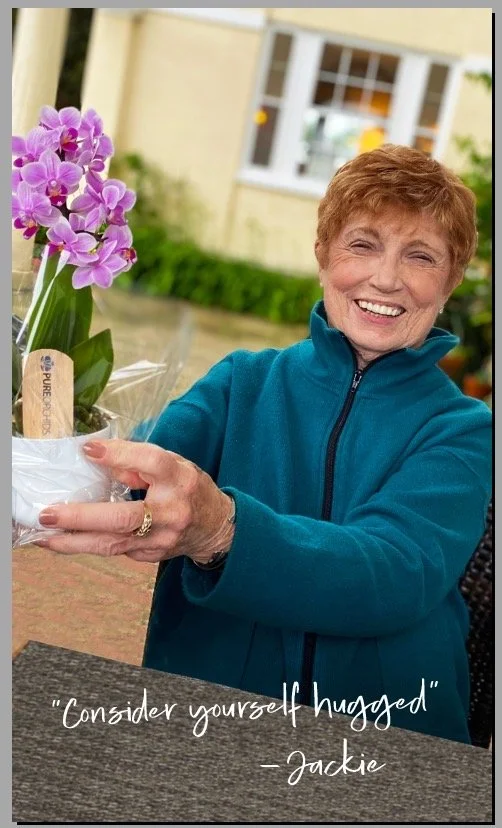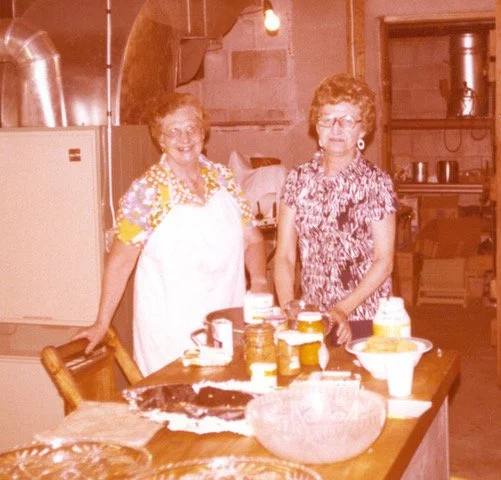Who Are the Quiet Helpers You Want To Thank In Your Life?
The Importance of Community Caregivers
Just a few months ago in my summer newsletter, I wrote about our 4,000 weeks of life and how I want to spend my limited time. I wrote, “I recognize my summers are numbered, and they’re especially numbered in having both of my daughters at home and my Mom still active at aged eighty-five…” In August, my Mom had some health complications, spent a week in ICU, and with a grim prognosis for recovery, she decided she was ready to die, and so we took her to our home for eleven days with end-of-life home hospice. It was a sad but beautiful experience, and she peacefully passed away with us by her side on August 21st. Obituary.
It's been a whirlwind, as so many of you know, with funeral preparations, all the paperwork, and getting her house ready for sale before winter hits. Let alone the grieving process.
While there is so much one could write about, what I really want to highlight are the community caregivers, those who showed up just when we needed them. These are the people who offer to go grocery shopping, or to stop by with a meal. When we were scrambling to find caterers for the funeral reception, I got an email, “Can I bring a dessert?” Dessert! Hadn’t even thought about dessert, yes, yes! I quickly went back to texts and emails of people who offered their help and asked for desserts. In minutes it was taken care of, and I was so grateful for anticipating what I didn’t even know I needed.
And then there were the “Monday’s St. Brigid’s girls.” St. Brigid’s Kitchen is a volunteer ministry that provides hot meals and pantry items in Brattleboro. My Mom was a part of it for years, so when I approached them about perhaps doing an estate sale to benefit St. Brigid’s, they were like an army of angels who swooped in, emptied the house of everything to put outside for the tag sale, and kindly said I didn’t need to be there. When I returned the next day to see what I needed clean up, I was shocked to see that all the items that didn’t sell had already been delivered to the local thrift store, and the things that needed to be tossed were neatly put into contractor bags lined along the driveway. I burst into tears for their generosity of time and spirit.
These community caregivers are often the unseen weavers of the social fabric of our communities, both at home and at work. I’d like to raise a toast to them and to make more visible the value they provide.
My grandmother (Rt.) and friend at Swedish Club in CT- 1970s
Community caregivers are the heroes who keep things together, both within families and workplaces. At home, they coordinate celebrations, prepare meals, and manage everyday logistics, offering emotional and practical support that nurtures family bonds. In the workplace, they are the people organizing birthdays, fostering team morale, and creating a supportive environment that builds cohesion and belonging among colleagues. Research shows that these roles enhance social connections and can lead to improved mental health and productivity, underscoring the essential role of caregiving in creating resilient, supportive communities.
That’s a lot of benefit, yet these tasks often go unrecognized and are disproportionately shouldered by women (just think of the millions of women who left their work for caregiving responsibilities during Covid.) We need greater visibility and equitable distribution to lessen burnout and to ensure these acts of care continue.
To create a more equitable structure for caregiving in communities, workplaces, and homes:
Make Caregiving Visible: Organizations should recognize and publicly acknowledge the contributions of caregivers. When caregiving roles are openly valued, they become less invisible, fostering a culture of appreciation that encourages broader participation. And after the Thanksgiving meal, a heartfelt thank you and helping with the dishes can go a long way.
Promote Shared Responsibility: By actively encouraging both men and women to take on workplace caregiving duties, organizations can normalize a more balanced approach. Team leaders can rotate caregiving-related tasks, like arranging celebrations, getting condolence cards signed, or group activities, so all employees experience the value and responsibility of these roles. This works with family events, too.
Implement Supportive Policies: Forbes magazine recently reported that 73% of employees have a secret second job- and it’s caregiving. To keep employees, workplaces can benefit from policies that provide flexibility and support to caregivers of any gender, such as flexible hours and paid leave for family caregiving.
By integrating these strategies, we can create spaces where caregiving is not only recognized but also supported as a shared role, benefiting both individuals and the community.
Great Link
While a bit idealistic (and maybe we need a little of that these days), this clip reminds us of the impact that small acts of kindness can have within a community, highlighting how caregiving can transform both individuals and communities. (5:44)
Reflection Exercise: Moving from Theory to Action
To support you in exploring and appreciating the roles of community caregiving in personal and work settings:
What small acts of kindness or care from colleagues or family members have had a lasting positive impact on me?
How do the community caregivers in my life, both at home and at work, impact my daily experience and overall well-being?
How do I contribute to creating a caring environment within my family or workplace? What specific actions or practices do I engage in?
In what ways might my assumptions or expectations be shaping who I see as “responsible” for caregiving roles?
How could I better recognize and celebrate caregiving contributions in my team or family? What might that look like in a daily or weekly practice?
What structural changes could be implemented in my workplace or home to support a more equitable distribution of caregiving responsibilities?
Quarterly Quote
“Service to others is the rent you pay for your room here on Earth.” - Muhammad Ali
Book Review
Being Mortal
By: Atul Gawande
I think my Mom would give this book a five-star review because she walked the path this book describes and made a courageous choice based on the minimum quality of life she needed to have a life worth living. This book has been a bestseller for nearly a decade, sparking important conversations about aging, healthcare, and end-of-life choices.
In Being Mortal, Atul Gawande examines the often unspoken realities that come with aging and terminal illness, encouraging readers to understand what it truly means to care for our loved ones in their final years. Through stories and research, he challenges us to shift our focus from purely medical solutions to understanding and honoring individual priorities and comfort, ultimately guiding us to make better decisions as caregivers and as individuals confronting our own mortality.





